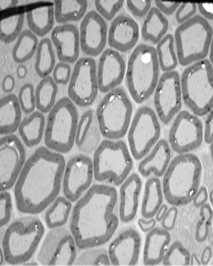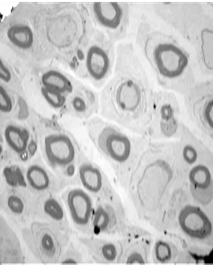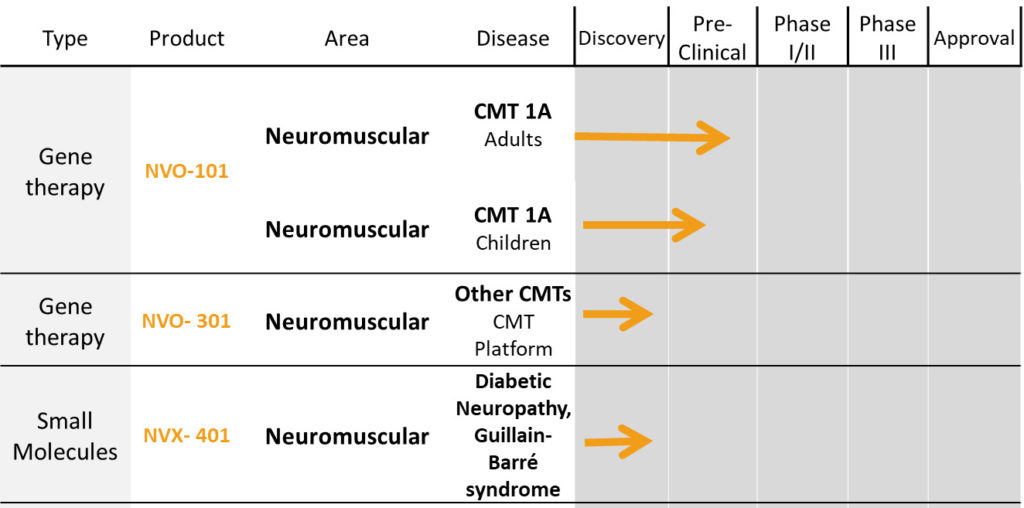OUR PIPELINE
MYELIN SHEATH DYSFUNCTION IS THE MAIN CAUSE OF PERIPHERAL NERVE DISEASES
Peripheral neuropathy results from damage to the nerves located outside of the brain and spinal cord (peripheral nerves), often causes weakness, numbness and pain, usually in the hands and feet. It can also affect other areas and body functions including digestion, urination and circulation.
Your peripheral nervous system sends information from your brain and spinal cord (central nervous system) to the rest of your body. The peripheral nerves also send sensory information to the central nervous system.
The causes of these neuropathies are traumatic injuries, infections, metabolic problems, inherited causes and exposure to toxins. One of the most common causes is diabetes.
Myelinated nerve

Demyelinated nerve

Charcot-Marie-Tooth diseases: hereditary peripheral neuropathies
Charcot-Marie-Tooth (CMT) diseases are hereditary peripheral neuropathies and among the most common of the rare diseases (1/2500). 80% of these diseases are demyelinating diseases, in which the cause is the loss of myelin sheath in peripheral nerves.
The main symptoms are sensory deficit (100% of cases), deformations of limb extremities (80% of cases) that require heavy orthopedic surgery (30%). No satisfying solution exists for these diseases at the moment.
Mutations in several genes can lead to CMT diseases. Type 1 and type 4 are demyelinating diseases, while type 2 are axonal diseases. A third type, IR-CMT are diseases with a mixted phenotype. https://neuromuscular.wustl.edu/time/hmsn.html. Nervosave Therapeutics has setup a gene therapy platform for CMT1 and CMT4 demyelinating peripheral neuropathies: NVO-301
CMT 1A: A SEVERELY DISABLING PERIPHERAL NERVE DISEASE
CMT1A represents 70% of demyelinating CMT diseases and 50% of all CMT diseases.
- Prevalence: 1 to 5/10,000 – 2.5M patients worldwide.
- Incidence: 300-2000 new patients per year in USA.
- Symptoms onset: 12 ± 7 years.
The main symptoms are sensory deficit (100% of cases), deformations of limb extremities (80% of cases) that require heavy orthopedic surgery (30%).
No satisfying solution exists at the moment.
Nervosave Therapeutics develop a gene therapy for CMT 1A: NVO-101. Click here to see our pipeline
Diabetic peripheral neuropathy: DPN
DPN or nerve damage is one of the most common cause of neuropathy of Type 1 and Type 2 diabetes. About 60% of the patients develop some form of very painful nerve damage. DPN is a progressive disease that can cause burning pain, numbness, and tingling in the hands and feet, for patients around 40 years old, often overweight, who have a high blood pressure & difficulties to manage their blood sugar level.
DPN involves polyneuropathy for about 35 million people in China, Europe & USA. Diabetic peripheral neuropathy
Nervosave Therapeutics will develop a innovative program NVX 401 to change DPN patient’s life . Click here to see our pipeline
Guillain-Barré syndrome: GBS
Guillain-Barré syndrome is an acute inflammation of peripheral nerves that affects up to 100 000 persons in USA and Europe. The disease occurs in both sexes of all ages but preferably in men (about 1.5 times more often than women). Orphanet
The disease has two main causes: the majority of the cases results from an acute myelin sheath degeneration (AIDP, Acute Inflammatory Demyelinating Polyneuropathy) while a minority of the cases results from an immune system attack against axons (AMAN, Acute Motor Axonal Neuropathy). About 90% of GBS cases in Europe and North America are AIDP. An infectious disease (mainly Campylobacter jejuni infection but recently Zika or SARS2 virus infections have been suspected) often precedes the onset of limb weakness. GBS -AIDP provokes a rapidly progressive muscle weakness that can cause acute neuromuscular paralysis, tingling, numbness, intense pain and cramps. Other sites like respiratory, deglutition, eye muscles can be involved: About 20% of patients need mechanical ventilation. Other manifestations like cardiac arrhythmias, hyper/hypotension and gastric dysmotility) may also occur. After a quite long recovery, many patients suffer from residual symptoms such as weakness, sensory disturbances, fatigue or pain.
NERVOSAVE THERAPEUTICS treatment, NVX-401, aims to both quickly slowdown and block the disease progression and to reduce recovery time and sequels. Click here to see our pipeline
PIPELINE

